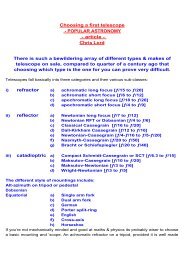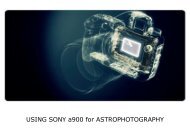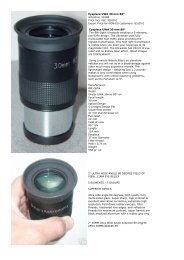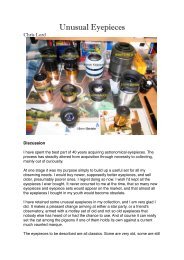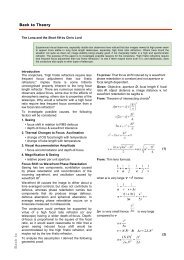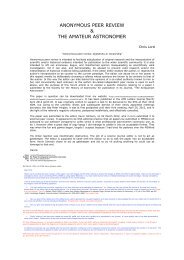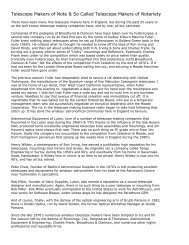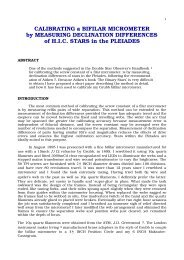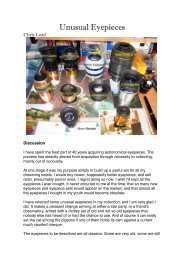Evolution of the Astronomical Eyepiece - Brayebrook Observatory
Evolution of the Astronomical Eyepiece - Brayebrook Observatory
Evolution of the Astronomical Eyepiece - Brayebrook Observatory
You also want an ePaper? Increase the reach of your titles
YUMPU automatically turns print PDFs into web optimized ePapers that Google loves.
EVOLUTION <strong>of</strong> <strong>the</strong> ASTRONOMICAL EYEPIECE<br />
EYEPIECE DESIGNS<br />
<strong>Eyepiece</strong> designs fall into six basic categories:<br />
solid; negative; orthoscopic;<br />
a c h romatic/wide-field; negative-posi -<br />
tive; compensating.<br />
A solid eyepiece is any which has only<br />
two air-glass surfaces, regardless <strong>of</strong><br />
<strong>the</strong> number <strong>of</strong> elements. The negative,<br />
negative-positive an d compensati ng<br />
types possess an internal field stop. All<br />
o<strong>the</strong>r types have an external field stop.<br />
Orthoscopic eyepieces are, in principle,<br />
those corrected for both coma and distortion.<br />
They are also corrected for longitudi<br />
nal spheri cal and ch ro m a t i c<br />
aberrations and lateral colour, usually<br />
over a field not wider than a radian<br />
(57°). Achro m a t i c / Wide-field types<br />
extend <strong>the</strong> fields and aberration correc -<br />
tion <strong>of</strong> simpler types, and encompass<br />
<strong>the</strong> majority <strong>of</strong> eyepieces developed<br />
over <strong>the</strong> past 150 years.<br />
SINGLE LENS EYEPIECES:<br />
The most primitive inverting eyepiece<br />
was recommended by Johannes Kepler<br />
in 1610 and bears his name. Originally<br />
it was an equi-convex lens, but it was<br />
realised that if <strong>the</strong> lens was altered<br />
such that <strong>the</strong> first sur face became<br />
shallower, or even plane, aberrations<br />
would be reduced slightly. Bearing in<br />
mind <strong>the</strong> very long focal lengths <strong>of</strong> <strong>the</strong><br />
single element refracting objectives<br />
used in astronomical telescopes<br />
throughout <strong>the</strong> C17th. Kepler’s eyepiece<br />
was all that was needed. The field<br />
<strong>of</strong> full illumination is given by:<br />
tan θ 2 = µ −1 ( ) − 1<br />
2. f / no.<br />
where m is <strong>the</strong> glass refractive index.<br />
Off axis aberrations become intolerable<br />
though when Θ > 15°, but since <strong>the</strong><br />
focal ratio <strong>of</strong> single element objective<br />
refractors was typically f/100, and <strong>the</strong><br />
biggest eyepiece lenses were no wider<br />
than 100mm, this limitation is somewhat<br />
academic.<br />
The exit pupil lies at:<br />
hence:<br />
Er ≈ Fe<br />
THE SPHERICAL LENS EYEPIECE:<br />
An extr eme form <strong>of</strong> equi-convex, first<br />
emplo yed by <strong>the</strong> micro s c o p i s t<br />
Leeuwenhoek, is <strong>the</strong> spherical lens.<br />
<strong>Eyepiece</strong>s <strong>of</strong> this form were made by<br />
William Herschel from 1768 onwards.<br />
The glass spheres were made by dropping<br />
beads <strong>of</strong> molten glass into water,<br />
and selecting and mounting <strong>the</strong>m in<br />
turned holders <strong>of</strong> lignum vitae. The<br />
focal length is given by:<br />
Fe =<br />
µ.r<br />
2 µ − 1 ( )<br />
⎛<br />
Fe 1 + 1 ⎞<br />
⎝ M⎠<br />
and beca use, for ordinary wi ndow<br />
cr own, m=1.5; Fe = 1.5r and Er =<br />
0.5Fe. To increase Er marginally, a flat<br />
was polished on <strong>the</strong> side facing <strong>the</strong> eye.<br />
Whilst secretary <strong>of</strong> <strong>the</strong> Royal Society,<br />
William Hyde Wollaston (1766-1828)<br />
devised a modified form <strong>of</strong> spherical<br />
magnifier, having a pair <strong>of</strong> plano-convex<br />
hemispherical lenses cemented<br />
back to back with a central field stop.<br />
David Brewster subsequently devised a<br />
larger version, with <strong>the</strong> edge hollow<br />
ground giving <strong>the</strong> finished lens <strong>the</strong><br />
appearance <strong>of</strong> a diablo. There followed<br />
o<strong>the</strong>r variants <strong>of</strong> <strong>the</strong> spherical lens<br />
magnifier. The Coddington, in which<br />
<strong>the</strong> first and second surface had <strong>the</strong><br />
same radius struck from a common<br />
centre; <strong>the</strong> field being defined by a central<br />
groove ground into <strong>the</strong> edge. About<br />
<strong>the</strong> same period (early C19th.) Charles<br />
Stanhope, <strong>the</strong> botanist, devised ano<strong>the</strong>r<br />
solid form, in which <strong>the</strong> field surface<br />
was made much shallower.<br />
18



